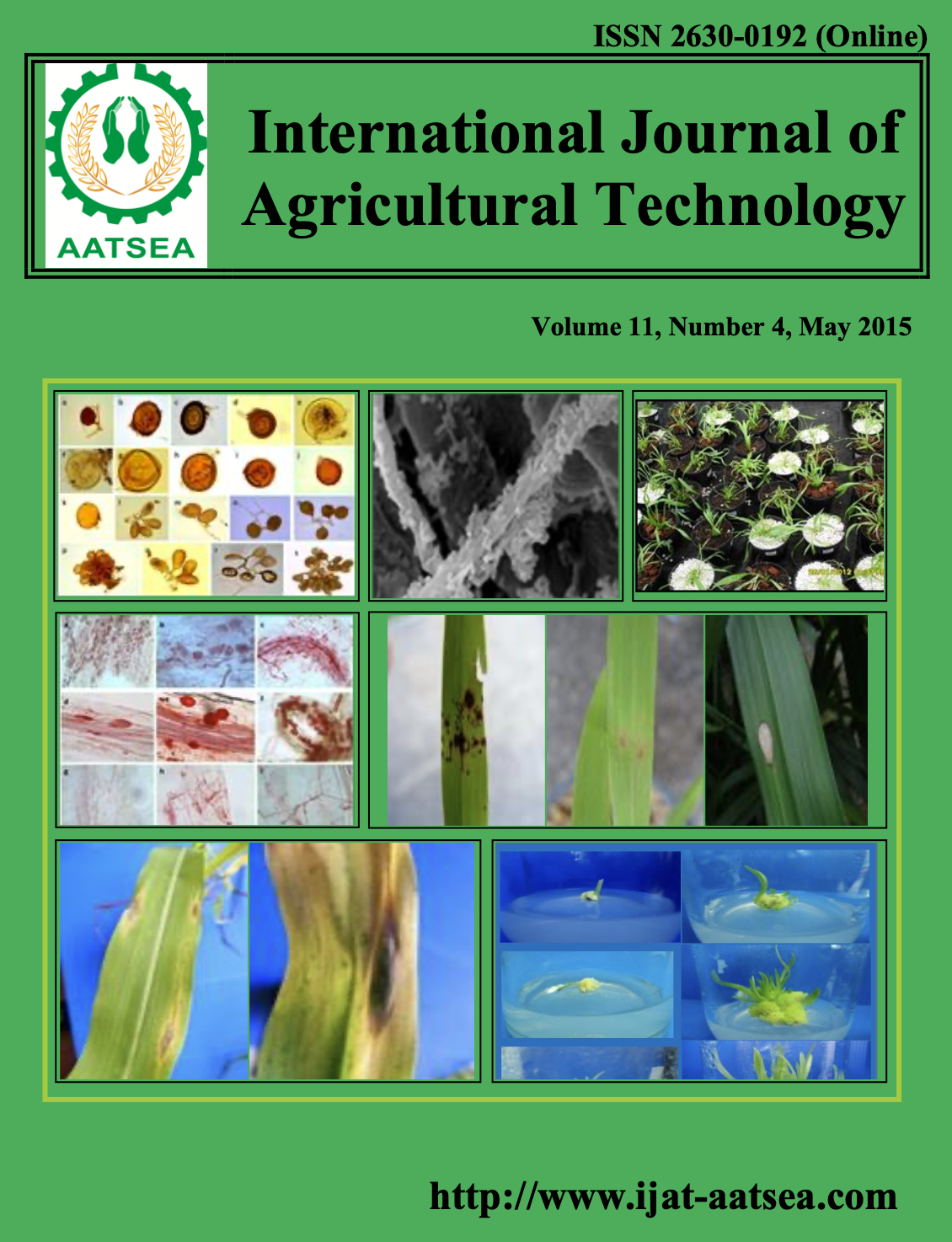Analysis of rhizobacterial community in field grown GM and non-GM maize soil samples using PCR-DGGE
Main Article Content
Abstract
This study assessed the impact of Bacillus thuriengensis genetically modified maize (GM Bt maize) on functional community of rhizobacteria. Denaturing gradient gel electrophoresis technique (DGGE) was used. Results indicated that band patterns of GM and non-GM samples were similar to each other at 30 days after sowing (DAS) and 1 day after harvest (DAH). Sequence analysis showed that uncultured bacteria, Actinobacterium, Bradyrhizobium spp., and Sphingomonas spp., were common in the soil samples indicating that these were a stable community and species. These findings showed that the GM maize did not alter the soil microbial community which is significant in the assessment of the impact of GM maize on rhizobacteria.
Article Details

This work is licensed under a Creative Commons Attribution-NonCommercial-NoDerivatives 4.0 International License.
References
African Center For Biosafety (2010). Genetically modified crops in South Africa. Reteieved from www.BiosafetyAfrica.net.
Aislabie, J. M., Chhour, K. L., Saul, D. J., Miyauchi, S., Ayton, J., Paetzold, R. F. and Balks, M. R. (2006). Dominant bacteria in soil of marble point and wright valley, Victoria land, Antartica. Soil Biology and Biochemistry 38:3041-3056.
Altschul, S. F., Gish, W., Miller, W., Myers, E. W. and Lipman, D. J. (1990). Basic local alignment search tool. Journal of Molecular Biology 215:403-410.
Babalola, O. O. (2010). Beneficial bacteria of agricultural importance. Biotechnology Letters 321:559-1570.
Brusetti, L., Francia, P., Bertolini, C. and Pagliuca, A. (2004). Bacterial community associated with the rhizosphere of transgenic Bt 176 maize (Zea mays) and its non transgenic counterpart. Plant and Soil 266:11-21.
Bumunang, E. W., Babalola, O. O. and Barros, E. (2013). Bacterial community profiling in the rhizosphere of field grown GM and non-GM maize. Journal of Pure and Applied Microbiology. pp. 1-21.
Chelius, M. K. and Triplett, E. W. (2000). Immunolocalization of dinitrogenase reductase produced by Klebsiella pneumoniae in association with Zea mays L. Applied and Environment Microbiology 66:783-787.
Danilo, E. (2004). PCR-DGGE fingerprinting: novel strategies for detection. Journal of Microbiological Methods 56:297-314.
Devare, J. S., Jones, C. M. and Thies, J. E. (2004). Effects of Cry3Bb transgenic corn and tefluthrin on the soil microbial community: biomass, activity, and diversity. Journal of Environmental Quality 33:837-843.
Hovig, E. B., Brogger, A. and Borresen, A. L. (1991). Constant denaturant gel-electrophoresis, a modification of denaturing gradient gel-electrophoresis, in mutation detection. Research 262:63-71.
Isik, I. and Guenther, S. (2008). Fate and effects of insect-resistant Bt crops in soil ecosystems. Soil Biology and Biochemistry 40:59-586.
James, C. (2011). Global perspective of biotech/gm crops and future prospects. Proceedings of the 15th Anniversary of Commercialization Ukraine, Ukraine ISAAA .
Lynch, J. M., Benedetti, A., Insam, H., Nuti, M. P., Smalla, K., Torsvik, V. and Nannipieri, P. (2004). Microbial diversity in soil: ecological theories, the contribution of molecular techniques and the impact of transgenic plants and transgenic microorganisms. Biology and Fertility of Soils 40:363-385.
Mehnaz, S. and Lazarovits, G. (2006). Inocuation effect of Pseudoonas putida, Gluconacetobacter diazotrophicus and Azospirillum lipoferum on corn plant growth under greenhouse conditions. Microbial Ecology 51:326-335.
Mehnaz, S., Weselowski, B. and Lazarovits, G. (2007). Sphingobacterium canadense sp. nov, an isolate from corn roots. Systematic and Applied Microbiology 30:519-524.
Muyzer, G. and Smalla, K. (1998). Application of denaturing gradient gel electrophoresis (DGGE) and temperature gradient gel electrophoresis (TGGE) in microbial ecology. Antonie Van Leeuwenhoek 73:127-141.
Muyzer, G., Waal, E. C. and Uitterlinden, A. G. (1993). Profiling of complex microbial populations by denaturing gradient gel electrophoresis analysis of polymerase chain reaction-amplified genes coding for 16S rRNA. Applied and Environmental Microbiology 59:695-700.
Oger, P. M., Mansouri, H., Nesme, X. and Dessaux, Y. (2004). Engineering root exudation of Lotus toward the production of two novel carbon compounds leads to the selection of distinct microbial populations in the rhizosphere. Microbial Ecology 47:96-103.
Saxena, D. and Stotzky, G. (2001). Bacillus thuringiensis (Bt) toxin released from root exudates and biomass of Bt maize has no apparent effect on earthworms, nematodes, protozoa, bacteria, and fungi in soil. Soil Biology and Biochemistry 33:1225-1230.
Schmalenberger, A. and Tebbe, C. C. (2002). Bacterial community composition in the rhizosphere of a transgenic, herbicide-resistant maize (Zea mays) and comparison to its non-transgenic cultivar Bosphore. FEMS Microbiology Ecology 40:29-37.
Stephen, J. R. and Kowalchuk, G. A. (2002). Ribotyping methods for assessment of in situ microbial community structure. In Bitton, G. (ed.), Encyclopedia of Environmental Microbiology, New York, USA: John Wiley and Sons.


